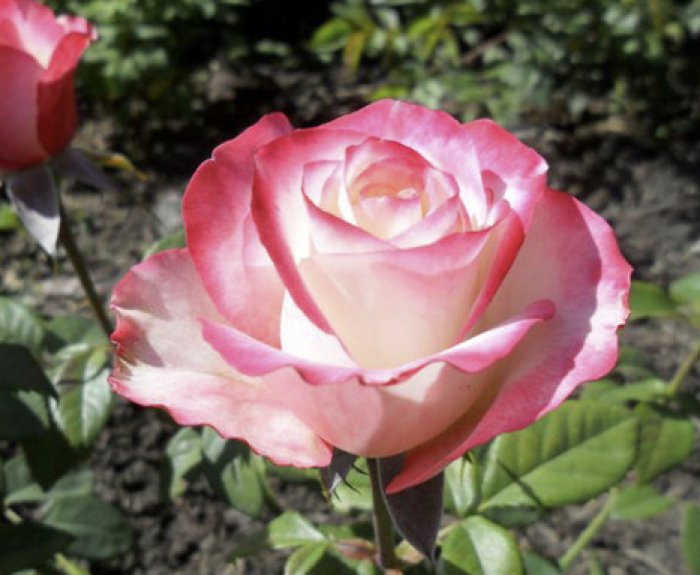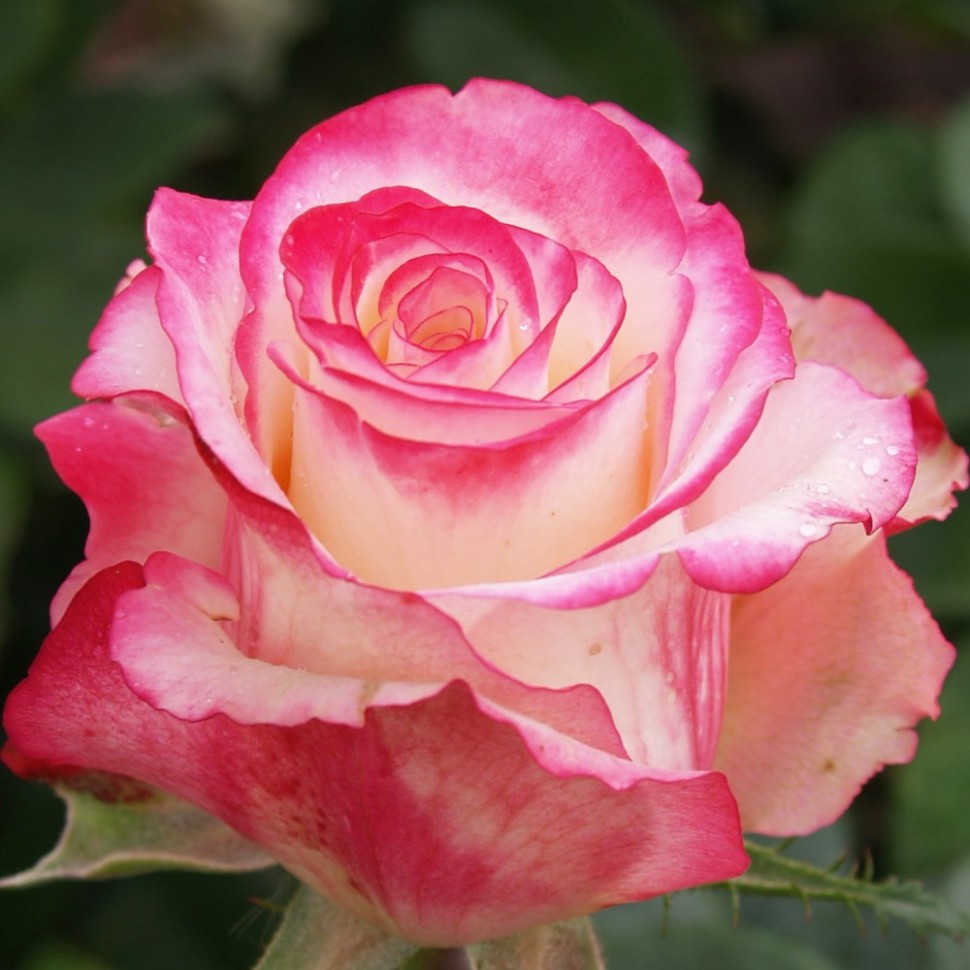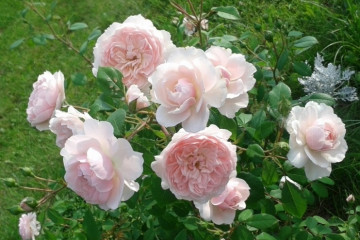Rose Sweetness - description of a varietal bush
Content:
It is not for nothing that the rose is called the queen of all colors. She is beautiful in any way. Currently, there are many varieties of roses, both basic and obtained by crossing several species. One of the most beautiful hybrids is Rosa Sweetness. The flower is not only a decoration of the garden, but also looks great in bouquets, therefore we are very fond of gardeners.
Rose Sweetness (Sweetness) - what is this variety, history of creation
Rose Sweetness is a hybrid tea variety, which has the second name Ecuador. The word Sweetness in translation means "sweetness". The flower received this name for its appearance, because it looks like a confectionery. The variety appeared in Germany at the end of the 19th century, tea and park remontant roses became the basis. The flower was bred by the breeder Gaito, who works in the Tantau nursery.
Brief description, characteristic
The plant is distinguished by beautiful glass-shaped flowers and consists of 60 velvety and wavy petals. The color of the bud is creamy, with a cherry edging at the tips. The length of the stem can reach 1 meter, the number of thorns is minimal, often they are completely absent. The leaf blades are distinguished by a rich green tint and dullness, the bushes are quite lush.
The buds are fragile, open slowly. The flower is large, it can reach 10 cm in diameter. There can be several buds on a branch, or one.
Sweetness hybrid tea rose smells very nice, the main flowering occurs at the end of June and lasts about a month. The variety belongs to re-flowering, so the buds can be observed until autumn.
Advantages and disadvantages of the variety
Gardeners note many advantages of the Sweetness rose, but there are also negative aspects. The positive aspects include:
- beautiful and elegant appearance;
- long flowering time;
- increased resistance to cold snaps;
- easy care.
Cons of the variety:
- the plant is often affected by fungal diseases;
- when watering with cold water and a lack of light, a negative reaction appears;
- the flower is difficult to tolerate rainy periods.
Use in landscape design
The flower is great for decorating a park area, recreation areas. Due to its beautiful appearance and pleasant aroma, the plant is often planted in groups of several bushes (from three to six). Sometimes it is used alone. The combination with other roses is not used, but in compositions the sweetness rose is in good harmony with bells, delphinium or lupine.
Growing a flower, how to plant it in open ground
Roses are quite capricious plants, despite the fact that some of them require little or no special care. First of all, the plant must be properly planted.
When and in what form is the landing
Sweetness rose is planted with seedlings. Planting a seedling is carried out in early May, when the soil has already warmed up well, so the plant quickly and easily adapts. Planting with seeds is not possible because it is a hybrid plant.
Location selection
It is important to prepare the site before planting. Pay attention to the soil. Rosa Sweetness loam is preferred, but rather loose. The place should be level, the presence of a slight slope is not excluded. You need to choose a well-lit area with protection from drafts.
How to prepare the soil and flower for planting
Before planting, holes are prepared with a diameter of about 40 cm. If there are several plants, then a distance of up to half a meter is left between the holes.
The seedling must have a well-developed root system, be free from signs of disease or damage. It is better if the shoot is no older than 3 years old. If the flower has an open rhizome, then several stems should be lignified. The kidneys need to be at rest.
For planting, it is better to choose grafted seedlings, because they better withstand negative climatic conditions and take root faster in a new place.
Planting procedure step by step
- Before planting, the seedling is soaked in clean water, the roots - in an aqueous solution of manure and clay.
- Humus is poured into the hole.
- Set the sprout so that the grafting site is located at a depth of no more than 6 cm.
- They fill up the soil, create a hill of earth around the plant.
- The flower is gently watered with warm, settled water.
In the future, it is important to monitor the state of the young plant and provide the necessary care in time.
Plant care
Rosa Svitnes is not too capricious, however, there are basic rules that should be taken into account and followed so that the bush develops well and pleases with abundant flowering.
Watering rules and humidity
Svitnee rose loves regular, but not abundant moisture. Watering is carried out by the irrigation method after the soil dries out. A swamp should not be arranged in the place of a flower, high humidity can cause rotting of the root system.
In the summer, watering is carried out once a week, in the fall it will be enough once every 2 weeks, in winter it is not needed at all.
Top dressing and soil quality
Proper feeding will allow the bush to develop well and bloom profusely. During the growing season, the plant is fertilized 4 times:
- Nitrogen urea will be needed in March or April.
- After three weeks, potassium phosphate is added.
- Organic fertilizers are used in May.
- A month later, re-introduction of organic matter is carried out.
Pruning and replanting
To form a beautiful bush, branches can be cut several times a year. The main stage is carried out until November, leaving stems no more than 30 centimeters in height by winter.
They do not like a rose transplant, but if necessary, the procedure can be carried out. The bush is dug up and transferred to a new place along with a lump of earth. In this case, the plant is less stressed and quickly adapts to new conditions.
Features of wintering a flower
Before winter, the flower is cut off. The base is covered with peat or sawdust, the shoots themselves are covered with coniferous branches. For shelter, you can use special materials.
Blooming rose
Sweetness roses bloom for a month, starting at the end of June. However, this variety is distinguished by the re-formation of buds after a short rest, therefore, from the beginning of autumn until frost, you can also enjoy beautiful flowers. Even after cutting, they retain their magnificent appearance for up to ten days.
Care during and after flowering
During flowering, the rose does not require special care. To stimulate the emergence of new buds, it is recommended to remove wilted flowers.
What to do if it does not bloom, possible reasons
The main reasons for the lack of flowers on the bush are improper care, disease and pest damage. It is necessary to carefully examine the flower and take measures to eliminate the cause that provoked the problem.
Flower propagation
Roses are bred by grafting. The best breeding season is spring. At this time, the plant adapts and develops better. By winter, it will already gain strength and easily endure a cold snap.
Detailed description
It is important to plant the grafted plant correctly:
- Before the procedure, the grafted rhizome is placed in water, and then in a solution of clay and manure.
- The sprout is planted in a prepared hole. The inoculation site should be deepened by about 3-5 cm.
- The seedling is watered, if necessary, add earth. After that, it is important to monitor the soil moisture.
Diseases, pests and ways to control them
The main diseases of Sweetness rose are fungal diseases. They develop at elevated ambient temperatures and humidity, with an overabundance of fertilizers. To combat the fungus, it is recommended to use fungicidal preparations and to carry out proper care.
Of the harmful insects for a flower, aphids are dangerous, which damages buds and flowers. To destroy it, plants are treated with special preparations.
Rose Sweetness is a beautiful flower that will delight any summer resident. The plant does not require special care, but to get a healthy crop with beautiful, abundant flowering, it is important to follow some rules.




















